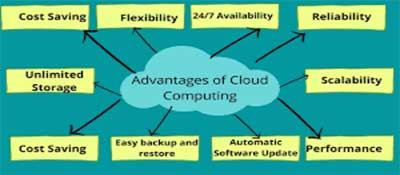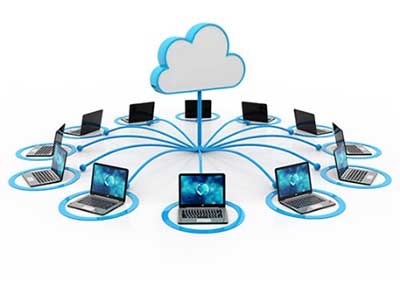GS-3: Awareness in the fields of IT, Space, Computers, robotics, nanotechnology.
Key words: Cloud computing, Iaas, Paas, Staas, Saas, Digilocker, GeM
Why in News:
From SaaS to IaaS to PaaS, the application of cloud computing has now become universal.
What is Cloud Computing?
Cloud computing is on-demand access, via the internet, to computing resources—applications, servers (physical servers and virtual servers), data storage, development tools, networking capabilities, and more—hosted at a remote data centre managed by a cloud services provider (or CSP).
Types of cloud computing:
- Public cloud: Public clouds are owned and operated by a third-party cloud service providers, which deliver their computing resources like servers and storage over the Internet. Microsoft Azure is an example of a public cloud. With a public cloud, all hardware, software and other supporting infrastructure is owned and managed by the cloud provider.
- Private cloud: A private cloud refers to cloud computing resources used exclusively by a single business or organisation. A private cloud can be physically located on the company’s on-site data center. Some companies also pay third-party service providers to host their private cloud. A private cloud is one in which the services and infrastructure are maintained on a private network.
- Hybrid cloud: Hybrid clouds combine public and private clouds, bound together by technology that allows data and applications to be shared between them. By allowing data and applications to move between private and public clouds, a hybrid cloud gives your business greater flexibility, more deployment options and helps optimise your existing infrastructure, security and compliance.
Types of cloud services:
Most cloud computing services fall into four broad categories:
- Infrastructure as a service (IaaS): IaaS provides you basic virtual compute infrastructure resources like CPU, Memory, Disk Storage attached to blank VMs with allowing you to install OS, using ISOs, from scratch and customization.
- Platform as a service (PaaS): Platform as a service refers to cloud computing services that supply an on-demand environment for developing, testing, delivering and managing software applications.
- Storage as a Service (STaaS): STaaS provides need based storage solution. It provides excellent alternative to the traditional on-site and dedicated storage systems and reduces the complexities of deploying and managing multiple storage tiers. Ex. Digi locker, google cloud.
- Software as a service (SaaS): Software as a service is a method for delivering software applications over the Internet, on demand and typically on a subscription basis. Users connect to the application over the Internet, usually with a web browser on their phone, tablet or PC. Ex. Google Workspace (formerly GSuite), Dropbox etc.

Advantage:

Challenges of Cloud Computing:
- Security and Privacy: Security and Privacy of information is the biggest challenge to cloud computing. Security and privacy issues can be overcome by employing encryption, security hardware and security applications.
- Portability: This is another challenge to cloud computing that applications should easily be migrated from one cloud provider to another. There must not be vendor lock-in. However, it is not yet made possible because each of the cloud provider uses different standard languages for their platforms
- Interoperability: It means the application on one platform should be able to incorporate services from the other platforms. It is made possible via web services, but developing such web services is very complex.
- Computing Performance: Data intensive applications on cloud requires high network bandwidth, which results in high cost. Low bandwidth does not meet the desired computing performance of cloud application.
- Reliability and Availability: It is necessary for cloud systems
to be reliable and robust because most of the businesses are now becoming
dependent on services provided by third-party.
Opportunities for Cloud Adoption in India:
- In India, all the sectors including Education, SME, Healthcare, & Government are looking at moving ahead and will significantly benefit from Cloud adoption.
- The health industry is also on the fast progression track and can utilize the cloud to create a national citizen health database. Cloud can help to enable telemedicine services to provide healthcare services in remote areas of the country where resources are in short supply. Ex CoWIN Portal , Aarogya Setu ,E-Vin portal
- Government agencies can leverage cloud infrastructure to quickly & effectively roll-out new services & schemes and can be utilized for collaborative working across geographically distributed offices. Ex: Kisan Suvidha.
- E-Gram Panchayat
- MeghRaj
- Kisan Suvidha
- DigiLocker
- eHospital
- In India, cloud computing has ensured the success of national initiatives and schemes such as Swachh Bharat Mission, e-Hospital, National Scholarship, My-Gov and e-Transport.
- One of India’s most landmark initiatives, the Government e-Marketplace (GeM) uses a multi-cloud architecture to ensure scalability.
NIC’s SaaS-based service, S3WaaS, has empowered district administrators to create, configure and deploy scalable and accessible websites without much effort and technical knowledge.
Way forward:
Cloud computing can further the motive of e-governance (service delivery, transparency, citizen awareness and grievance redressal) by providing a faster, easier and cost-effective platform that can be used by multiple government agencies. Way ahead lies in taking due care of security, interoperability and licensing.
Source: the Hindu (text and context)
Q..Digi locker, Google Cloud and Amazon Web cloud based service in India is an example of which of the following type of cloud service?
a) Infrastructure as a service
b) Storage as a Service
c) Software as a service
d) Both A and B
Ans: D









